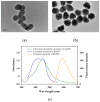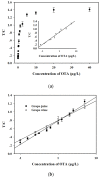Silver Nanoparticle-Based Fluorescence-Quenching Lateral Flow Immunoassay for Sensitive Detection of Ochratoxin A in Grape Juice and Wine
- PMID: 28264472
- PMCID: PMC5371838
- DOI: 10.3390/toxins9030083
Silver Nanoparticle-Based Fluorescence-Quenching Lateral Flow Immunoassay for Sensitive Detection of Ochratoxin A in Grape Juice and Wine
Abstract
A silver nanoparticle (AgNP)-based fluorescence-quenching lateral flow immunoassay with competitive format (cLFIA) was developed for sensitive detection of ochratoxin A (OTA) in grape juice and wine samples in the present study. The Ru(phen) 3 2 + -doped silica nanoparticles (RuNPs) were sprayed on the test and control line zones as background fluorescence signals. The AgNPs were designed as the fluorescence quenchers of RuNPs because they can block the exciting light transferring to the RuNP molecules. The proposed method exhibited high sensitivity for OTA detection, with a detection limit of 0.06 µg/L under optimized conditions. The method also exhibited a good linear range for OTA quantitative analysis from 0.08 µg/L to 5.0 µg/L. The reliability of the fluorescence-quenching cLFIA method was evaluated through analysis of the OTA-spiked red grape wine and juice samples. The average recoveries ranged from 88.0% to 110.0% in red grape wine and from 92.0% to 110.0% in grape juice. Meanwhile, less than a 10% coefficient variation indicated an acceptable precision of the cLFIA method. In summary, the new AgNP-based fluorescence-quenching cLFIA is a simple, rapid, sensitive, and accurate method for quantitative detection of OTA in grape juice and wine or other foodstuffs.
Keywords: fluorescence quenching; lateral flow immunoassay; ochratoxin A; quantitative detection; silver nanoparticles.
Conflict of interest statement
The authors declare no conflict of interest.
Figures





Similar articles
-
Ochratoxin A: an improvement clean-up and HPLC method used to investigate wine and grape juice on the Polish market.Food Addit Contam. 2005 Feb;22(2):158-62. doi: 10.1080/02652030500038066. Food Addit Contam. 2005. PMID: 15824006
-
Ochratoxin A in wine and grape juice sold in Canada.Food Addit Contam. 2004 Oct;21(10):971-81. doi: 10.1080/02652030400000653. Food Addit Contam. 2004. PMID: 15712522
-
A novel magneto-gold nanohybrid-enhanced lateral flow immunoassay for ultrasensitive and rapid detection of ochratoxin A in grape juice.Food Chem. 2021 Jan 30;336:127710. doi: 10.1016/j.foodchem.2020.127710. Epub 2020 Jul 31. Food Chem. 2021. PMID: 32763739
-
Occurrence of ochratoxin A in wine and ochratoxigenic mycoflora in grapes and dried vine fruits in South America.Int J Food Microbiol. 2006 Sep 1;111 Suppl 1:S5-9. doi: 10.1016/j.ijfoodmicro.2006.02.006. Epub 2006 May 22. Int J Food Microbiol. 2006. PMID: 16716424 Review.
-
An overview of ochratoxin A in beer and wine.Int J Food Microbiol. 2007 Oct 20;119(1-2):79-83. doi: 10.1016/j.ijfoodmicro.2007.07.029. Epub 2007 Jul 31. Int J Food Microbiol. 2007. PMID: 17716764 Review.
Cited by
-
Multifunctional Smart ZnSe-Nanostructure-Based Fluorescent Aptasensor for the Detection of Ochratoxin A.Biosensors (Basel). 2022 Oct 8;12(10):844. doi: 10.3390/bios12100844. Biosensors (Basel). 2022. PMID: 36290981 Free PMC article.
-
The Effects of Different Antigen-Antibody Pairs on the Results of 20 Min ELISA and 8 Min Chromatographic Paper Test for Quantitative Detection of Acetamiprid in Vegetables.Biosensors (Basel). 2022 Sep 5;12(9):730. doi: 10.3390/bios12090730. Biosensors (Basel). 2022. PMID: 36140115 Free PMC article.
-
Nucleic acid lateral flow assays using a conjugate of a DNA binding protein and carbon nanoparticles.Mikrochim Acta. 2019 Jun 11;186(7):426. doi: 10.1007/s00604-019-3544-0. Mikrochim Acta. 2019. PMID: 31187248
-
Change of Amino Acid Residues in Idiotypic Nanobodies Enhanced the Sensitivity of Competitive Enzyme Immunoassay for Mycotoxin Ochratoxin A in Cereals.Toxins (Basel). 2020 Apr 23;12(4):273. doi: 10.3390/toxins12040273. Toxins (Basel). 2020. PMID: 32340239 Free PMC article.
-
Competitive ratiometric fluorescent lateral flow immunoassay based on dual emission signal for sensitive detection of chlorothalonil.Food Chem. 2024 Feb 1;433:137200. doi: 10.1016/j.foodchem.2023.137200. Epub 2023 Aug 25. Food Chem. 2024. PMID: 37678117 Free PMC article.
References
-
- Lai W., Fung D.Y.C., Yang X., Renrong L., Xiong Y. Development of a colloidal gold strip for rapid detection of ochratoxin A with mimotope peptide. Food Control. 2009;20:791–795. doi: 10.1016/j.foodcont.2008.10.007. - DOI
-
- Li J., Duan H., Xu P., Huang X., Xiong Y. Effect of different-sized spherical gold nanoparticles grown layer by layer on the sensitivity of an immunochromatographic assay. RSC Adv. 2016;6:26178–26185. doi: 10.1039/C6RA03695C. - DOI
Publication types
MeSH terms
Substances
LinkOut - more resources
Full Text Sources
Other Literature Sources
Molecular Biology Databases

